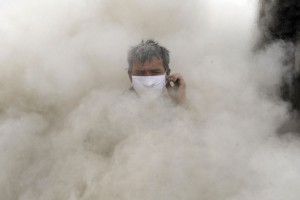By Smriti Gopal
Just as Bhutan’s cultivation season begins to creep in around August/September 2015, farmers probably will be concerned about the dust falling onto their farms, from the nearby roads. It’s possible that some people feel, the dust is coming in from construction work nearby and many places in Bhutan seem to be suffering from this dust pollution.
So in order to prevent or reduce the amount of dust polluting Bhutan’s farms, people in Darkar Gewog (district) in Bhutan, have apparently requested Gewog’s Administrator to ask the Renewal Natural Resources (RNR) officials to inspect the dust pollution on the crops. A recent report from June 2015, suggests that people in Darkar Gewog told the Administrator that the dust in this area is coming from the operating stone quarries nearby.
It looks as though, the Mangdechhu Hydroelectric Project Authority (MHPA) has also been monitoring the dust pollution, affecting the farms. The MHPA’s Officiating Chief Environment Officer said: “[We] sprinkle water on the road whenever it is required.” However, if sufficient water is not sprinkled on the roads (connecting to the nearby farms) in time, it is likely the dust will affect farmers’ cultivation of crops.
It’s claimed, a few women in Langthil Gewog in Bhutan, recently spoke to the Bulletin Board System. These women said: “Had it not been for the timely rainfall recently, [we] would have had to harvest buckwheat along with the dust.”
 According to recent reports, the construction work of the MHP plant in Trongsa district central Bhutan, is possibly affecting nearby farms, districts and villages. Some reports predict that the MHP plant plans to be completed during mid-2016/17. Unfortunately farmers and other people will probably struggle to cope with the dust pollution till then.
According to recent reports, the construction work of the MHP plant in Trongsa district central Bhutan, is possibly affecting nearby farms, districts and villages. Some reports predict that the MHP plant plans to be completed during mid-2016/17. Unfortunately farmers and other people will probably struggle to cope with the dust pollution till then.
Presumably, being a large construction site, this area is reported to include a 152metres-high surge shaft and two steel-lined pressure shafts that will be 1,853metres-long. These two steel-lined pressure shafts will be 3.5metres in diameter. These measurements hopefully give a glimpse of the scale of the site. Even though it probably sounds like a large construction site, the MPHA is apparently taking all steps to minimise dust pollution and other adverse impacts on nearby farms.
Crops such as maize, chillies, fruit and vegetables are usually grown on these nearby farms which are affected by the dust pollution. The MHP plant presumably, has been of very little advantage to the people so far. Probably farmers have found it difficult to sell good products after harvesting these from the dust.
A farmer from Draagteng in Bhutan, Nidup Dorji said: “Not just maize and chilies, the dust does not even spare cattle fodder. The MHPA does not listen to [us] when [we] put forward a complaint.” It’s claimed that vegetables are usually imported to these farms, from India. A lot of the groceries in Bhutan apparently caters specifically towards farmers and their produce.
Langthil district’s farmer, Pango said: “Fruit trees do not bear fruit after it is covered with dust. Even the leaves get blemished.” Some people believe that if these crops cannot be sold, this can unfortunately have a negative impact on Bhutan’s economy.
Reports suggest that it is Bhutan’s initiative for the MHP plant to generate 10,000MW hydropower by 2020. No wonder Bhutan’s government probably feels it’s better to keep building hydroelectric plants. While most of the electricity generated by the MHP plant will be used in Bhutan, the excess electricity is reported to be exported to India. As for the dust pollution, hopefully people in Bhutan will eventually be able to sell their produce without dust pollution affecting their farms.




















